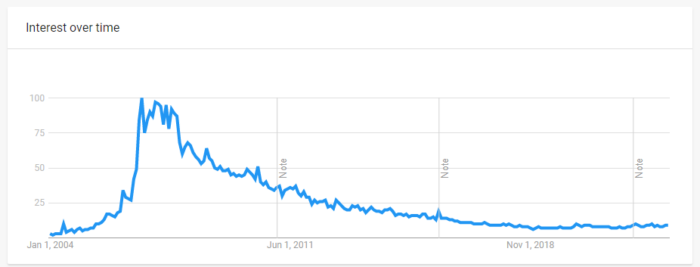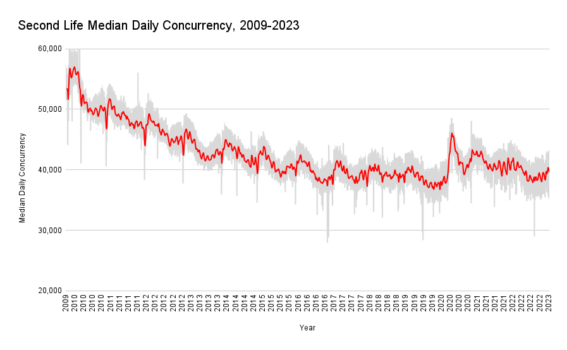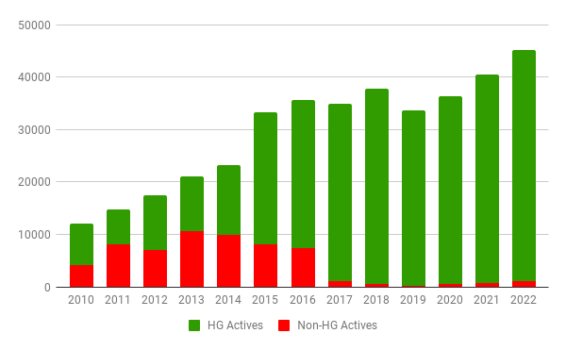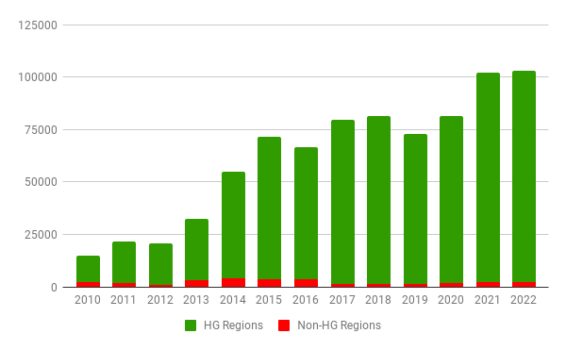
Hi, everyone. This is me, Maria, your friendly local technology reporter and blog editor. You might know me from such things as my annual OpenSim stats presentations at the OpenSimulator Community Conference, my various attempts to run an OpenSim grid on my home computer, or the fact that, since 2009, I’ve written over 2,200 articles about OpenSim and the metaverse — and edited more than 1,000 others — for this very site you’re reading now.
The reason that I started Hypergrid Business was because I could see the future, and the future was the metaverse. An open-source, distributed, decentralized metaverse. You know, like the OpenSim hypergrid. And I thought it was the coolest thing ever, and nobody was writing about it. So I would.
I still believe in the future of an open-source, distributed, decentralized metaverse. And I still think that, of all the technologies out there today, the OpenSim hypergrid still comes the closest to that vision. I believe that the metaverse will change everything. It will change the way we socialize, the way we learn, the way we work. But it might not happen quite as soon as I though it would.
The metaverse is still a technology solution searching for a problem to solve. Mostly, that’s because the technology isn’t quite there yet. The headsets make people nauseous. Zoom is good enough for most virtual meetings. The learning curve for virtual world browsers is too high for casual users. And the killer use cases just aren’t there yet. The only solid non-gaming applications I’ve seen for it so far — the ones worth the money and the learning curve — are when it comes to high-end product design. Really high-end. I’m talking ships and cars and buildings, where distributed teams from all over the world can do virtual tours of 3D mockups and talk about design decisions, safety issues, production hurdles, and marketing plans. These are use cases where a single immersive meeting can save a company tens of thousands of dollars in travel costs and thousands — or even millions — of dollars in prototype costs. Plus, the meetings are typically short enough and don’t usually require too much walking around, meaning that people don’t get quite as sick.
But that’s about it. That feeling of presence — of sharing a location with other people — is magical. But it doesn’t make up for all the shortcomings of either desktop-based virtual worlds, or 3D virtual environments, for most non-gaming applications. So yes, desktop-based immersive virtual worlds — also known as first-person shooters — have taken over when it comes to games. Yes, Minecraft is super popular. But it hasn’t really translated yet to non-gaming applications on any significant scale.
We’re still waiting for killer apps. We might be waiting for a while. I think things will start to change when we have a decent interface or better VR hardare. I know the Firestorm team is awesome, but they’re constrained by having to support Second Life, and the OpenSim community is too small to support its own viewer. I’m worried that Second Life has poisoned the well when it comes to general-purpose, user-build virtual environments because the company did nothing to capitalize on its early media hype.

The media — myself included — got excited about the potential of Second Life. It became a plot point in TV shows and made the cover of Businessweek. I guess Linden Lab thought that they’d keep getting free publicity forever, and didn’t bother to invest in any real marketing, user interface design, or anything else that would make it a viable product in the long term.
Second Life’s concurrency statistics have mirrored general interest. Over time, according to data from Grid Survey, concurrency numbers have trended down.

The one notable exception to the downward trend was in early 2020, when the pandemic first hit and people were stuck inside and usage jumped for the first time in a decade — but then started trending down again.
Land area, Second Life’s main revenue source, is also down. From a peak of 31,988 regions in 2010, total land area is now down to 27,630 regions, only two-thirds of which are privately owned and a fifth of which is abandoned land.
OpenSim numbers have tended in the opposite direction — both land area and active users have trended up over the years.

In the early days of OpenSim, as you can see in the chart above, a substantial portion of the user base was on non-hypergrid worlds, mainly InWorldz and Avination. Those two grids shut down and, since then, nearly all the user growth has been on the hypergrid.
In land area, the difference is even more dramatic, since hypergrid-enabled worlds tend to offer lower-cost land, and some even offer free land, if users are able to run the regions on their home computers.

Of course, it’s hard to compare OpenSim directly to Second Life.
First of all, Second Life no longer publishes active monthly user numbers. The most recent numbers are from 2010, when Second Life reported more than 1 million active monthly users. However, historically, Second Life monthly active users have been, on average, 19.8 times that of median daily currency. That translates to as between 700,000 and 850,000 active monthly users this year.
By comparison, OpenSim’s user base is a drop in the bucket.
On the flip side, OpenSim’s land area is more than three times that of Second Life, mostly due to the availability of free and extremely low-cost regions. In fact, the average cost of a standard sized region in OpenSim is less than $13 a month.
What I suspect is happening is that people who don’t need Second Life’s large communities are coming over to OpenSim to get better deals on land and more control over their virtual environments.
You can get a free region on OSgrid by running it on your own computer, or set up a free OpenSim grid of your own using the DreamGrid installer, or have a hosting company set up a grid for you, or rent land from an existing grid. As a region owner, you typically get the ability to save a copy of the entire region in order to keep a backup, or to share or sell to others. As a grid owner, you can restrict who can visit your grid, you can rent out land, and you can run your own currency.
For builders in particular, having an OpenSim grid or region as a must — even if they spend the bulk of their time in Second Life. Building in OpenSim means that you keep the original copies of all your builds in a safe place, and can work with a team on the builds. Building in Second Life is riskier, especially commercial builds created by large teams, due to lack of good backups and ownership issues.
Piracy and copyright aren’t as big a deal. Most content theft happens in Second Life because that’s where most of the content is. And most stolen content is also distributed in Second Life, because that’s where most of the users are. In OpenSim, however, grids have the power to ban griefers and other users who infringe on copyright, and close off hypergrid teleports to grids that don’t follow the law. Plus, the largest platform for content sales — the Kitely Market — has a strong process in place to remove infringing content, with a “report product” button on every individual listing.
The bigger problem is the lack of user base.
For individual users, some find OpenSim grids to be cozier and friendlier than the Second Life environment.
But I suspect that one of the biggest sources of OpenSim users is large role play groups and communities. By coming to OpenSim, these groups are able to set up their own continents at a low cost, or even launch their own grids. They can have more land and more control for substantially less money than they would spend in Second Life.
Another source of OpenSim users is school, which benefit from having closed grids where they can tightly control the content and the people who can access them. However, since these grids are private and generally run behind school firewalls, they do not show up in OpenSim statistics, which are based on public grids.
With the exception of school environments, I personally haven’t met any users who came to OpenSim directly without any experience in Second Life first. That means that OpenSim is fed by the Second Life diaspora, and in intrinsically limited not just by Second Life’s technology but also its dwindling user base.
There’s still a lot of room for growth — we can easily increase OpenSim’s users by a factor of ten or more, just by better marketing OpenSim’s cost advantage.
But, to get beyond that, OpenSim has to able to market itself to the wider world.
As part of that effort, a few years ago, I began covering wider trends in virtual reality. The idea is that people interested in virtual reality are also potentially interested in virtual worlds, and might take a look at OpenSim once they come to the site and find out that it exists. I also offer free ads to everyone in the OpenSim community. Whether you sell stuff on the Kitely Market, have a grid where people can rent land, or run virtual events, or offer building or consulting services, you can get a free ad on Hypergrid Business.
This year, we will be expanding our coverage of AI. There’s a chance that some of the people interested in AI are also interested in virtual environments, and will take a look at OpenSim while they’re here.

If you are looking to promote OpenSim to the wider audience, I recommend jumping on the AI bandwagon while interest is high.
For example, you could contribute articles about how to build an AI-powered non-player character in OpenSim. Or how to use AI to generate virtual environments in OpenSim. Or how to use AI to generate scripts.
Or, if your grid already has AI-powered NPCs, you can send me a press release about how to visit your grid and interact with these bots. Which reminds me. Here’s how you can use ChatGPT to write a press release.
Also, contact me if you want to become a technology reporter, or columnist, and want to write about AI. Or if you want to write about events happening in OpenSim, or how-to-guides about getting started. I’m also going to be launching a YouTube channel, if anyone wants to be a guest or co-host.
My email is maria@hypergridbusiness.com. Feel free to get in touch.
- Kitely Mega Worlds on sale for $90 per month - July 19, 2024
- OpenSim regions up, actives down with summer heat - July 15, 2024
- People think AIs are conscious. What could this mean for bots in OpenSim? - July 12, 2024
